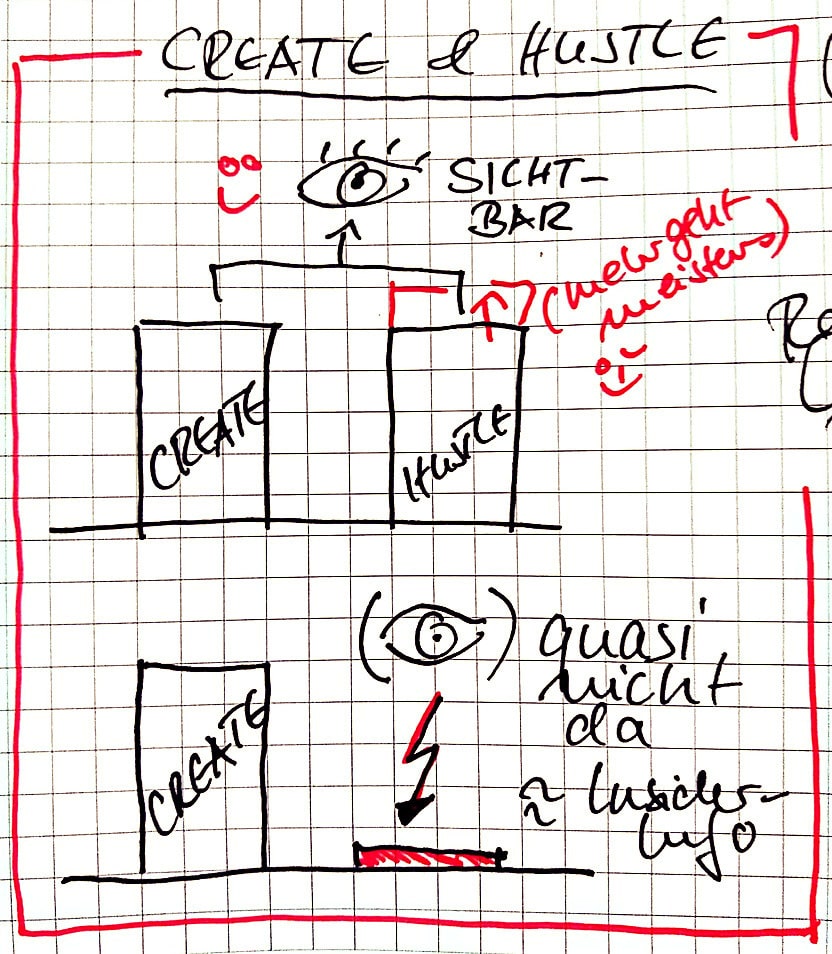Why is it so hard to get from your Minimum Viable Product to Go-To-Market?
Last week I had a chat with one of our nice nerdy clients… After we had warmed up a bit around the funny spleens of his in-home office cat,
he gave away his secret.
With a bit of a hushed voice he admitted:
“Kristin, I barely dare tell you this…. As of today, we have exactly 17 minimum viable products sitting on the line. Basically ready to sell. We LOVE developing them, but then for some reason, we never really get around selling them.”
You know what?
He is not the only one
(and I told him so immediately so he could stop wondering what’s going on…).
(If you don’t know what a minimum viable product, or MVP, is, have a look here. It’s a word to know if you’re thinking about putting a product out there!)
Can you even imagine the potential contribution and wealth of solutions and yes, money to be earned?
It’s not creating the marketing plan, it’s not even the decisions about all things marketing such as name, logo, etc. – this is actually fun, isn’t it?
The real problem, or actually the 2 problems regarding the minimum viable product that usually come up are:
- a) for the creator of the product it FEELS as if it is DONE, complete, it became what he or she had in mind – and THAT. IS. IT.
- b) the other part of it is even more mental… it is the internal reluctance to really go out there and quite literally OUT yourself and your minimum viable product. To really seek and entangle your product and yourself in the confrontation with the market and its needs and its feedback. Here you open the door – and what may come in could be…. let’s face it… it could be a failure. It could turn out that no one besides you is so much in love with your baby. Or it could turn out that while you were busy creating, someone else was not pondering so much, hasn’t felt this reluctance, and just put it out there.
Both those effects are massively human and can be expected to pop up – besides the need to put in the effort and get professionally prepared for the go-to-market.
Let’s start tackling them, ok?
So, first things first.
Your reluctance might be justified.
You might sense, that indeed, the code works but the marketing and sales and maybe also the support part is not really prepped for success and that therefore your chances of success are simply minimal. Because out there, the other guys and chicas who got their Minimum Viable Product all prepped up… yep, they will have a massive advantage vs. you and your product.
What’s the fix here? It might not be THE quick fix, but the EFFECTIVE one.
1. Make sure your preparation for the go-to-market is pro-level, not amateur
Simply make sure you get all you need to give your product and your work a fair chance of success. With SAAS products this might be (overview, not necessarily complete):
- Ideal Customer Avatars and Personas with detailed profiling as to their needs, pain points, etc.
- Accordingly a basic product description from the user, NOT the developer’s point of view (! trust us, this is not the same!) – that can be used for sales info, for your first landing page, or for future homepage and blog
- A good marketing and sales roadmap and/or playbook that helps you define what will be tested how, where, and with what budget
- and no:
Do not mix up deliberate systematic testing with clueless trying out whatever comes to mind – it would tragically bury your minimal viable product’s potential success!
2. Understand how the / your creative mind works
At OVERW8 we work mostly with entrepreneurs or entrepreneurial souls.
This is pretty much synonymous with… creative people.
Being creative is such a marvelous gift, especially if you manage to be a productive creative. Most people we work with do have that gift of having at least amazing ideas and in many cases already know something about how to get from an idea via execution to make it a reality.
However, what we can help with in most the cases are these coaching hints:
a) There will always be more Golf. Ahem. Ideas.
Truly, as a creative person, you can trust this truth.
Ideas seem to be a little bit like rabbits – got some of them and they will soon appear to have multiplied. ?
The problem with this is that while we are working on turning one idea into reality, naturally other ideas turn up on the way. Those ideas will be shiny new things, they will wink towards you, give you the eye, and overall will want to distract you from really getting over the finish line.
Also, it is valuable info that the finish line in the case of software is NOT having coded a first version of whatever you had in mind, it is actually
- being active with it in the market,
- having customers use it,
- making money from it.
Only then your software is in business, not a hobby or experiment in your lab (which might be rewarding, too, but is a different goal).
This ties in closely with the fact that
b) The farther down the execution funnel you get, the less fun it is
For one of our earlier digital media projects, The Club of Happy Lifepreneurs, we cooperated with a fabulous creative coach from the U.S. – Cynthia Morris. I met her at Crea Conference in Italy and our creative minds immediately connected. I was super humbled that we could have some of her insights and valuable content on our portfolio.
In “Crossing the finish line” she explains how the creation process works mentally:
Whenever you start out with a new idea, getting into execution is simply fun.
There are soooo many possibilities, you get to decide among them like on a buffet. Life is great, the clouds are fluffy today.
However, the further you progress in executing your idea, the more choices you will have made.
Each decision gives your idea more shape and more concreteness (which is good), at the same time, the choices narrow down on the way. Also, real-world problems kick in now, some features might simply not work (yet) as you imagined them (if ONLY one could just beam them out of the head into the world, right?) and this can be depressing.
The darkest moment is shortly before dawn.
Now you’re at the very narrow end of the process, you literally feel squeezed, it is uncomfortable and you might be wondering why you ever thought that this might be a good idea to execute at all. It is important not to give up now. You are actually much closer to the light than you might guess – at least if you don’t duck away from dealing with all the nitty-gritty details that characterize that last project phase (or get someone to do it for you. You’re an entrepreneur, after all. Your decision, remember? ;))
c) The work actually begins when creative people think it’s done, a minimum viable product is not final!
The creation of something – at least in terms of doing business based on it – is not really done once we creatives feel it is done.

It is perfectly fine to consider a book ‘complete’ once it is printed for the first time if writing it was a goal in itself. In that case, finishing the manuscript might already be sufficient for considering the process ‘complete’.
However, if we think about it from a business perspective, then
- only phase 1 – the creation of the basic product – is completed, and
- now phase 2 – “Hustle” – the promotion, the marketing, and the sales process can start.
If we leave out phase 2 “Hustle”, that is perfectly fine in case we just want to write a certain book and actually prefer that no one reads it.
If we create something to do business with it, creating it is only phase 1.
BTW: Please do not assume that I am preaching this here from a background of never having been guilty of this… 100% to the contrary.
And it begins on even much simpler levels than product development… it begins with the great concept you develop for a certain trade fair but do not plan PR in to get the message spread.
The scribble above therefore is often used when coaching our clients.
Most feel totally fine with what is shown on the lower level:
CREATING? Oh, hell yes!
HUSTLE? Please! Marketing? Nah! Sales? Okaaay, if there’s really no other way.
Do you know what the real problem here is?
Can you see where that adds up?
All the fame (and money) goes to the (quality-wise) mediocre hustlers!
(and this happens quite often, right?)
On the one hand that is not really fair, is it?
The low-quality things get all the visibility while the high-quality products starve down the road.
Then again it IS fair – as it simply goes along the lines of
Where perception goes, energy flows.
Approach that mechanism like this:
The creation phase is the main investment phase.
The hustle phase – adding some more investment – is payback time.
This is where ROI can and will happen.
Or putting it bluntly:
No hustle, no money.
One last hint here:
So, let’s wrap this up, shall we?
4 ways to get out of the way of your Minimum Viable Product – and your ROI
- If you’re a creative person and love turning your brilliant ideas into reality – please, stick with it.
- Recognize and manage the sheer quantity of your ideas. Find a way to not get stuck with the new ones before completing the one you’re on. Jot them down, store them in MIRO – but get them out of your (current) way.
- Plan in the psychology of the project execution funnel and its tricky finish-off phase. Push through. Stay on your game. Definitely not the moment to give up.
- Get hustle mode on your plate – or know-how and where to delegate it. Do not let the mediocre pro hustlers get the cake.
Over to you… ever experienced something similar?
- How many ready-for-launch products are getting their beauty sleep in your cellar?
- How different would things turn out for your products and your company if you challenged those classic blocks?
Get in touch if you can use some advice for your very own roadblocked project!
We would love to help you get your project out there. The world deserves to see it and you deserve to pick the cherries of your hard work.
You can contact us here!
[Edited on June 13th, 2022]












Leave a Reply